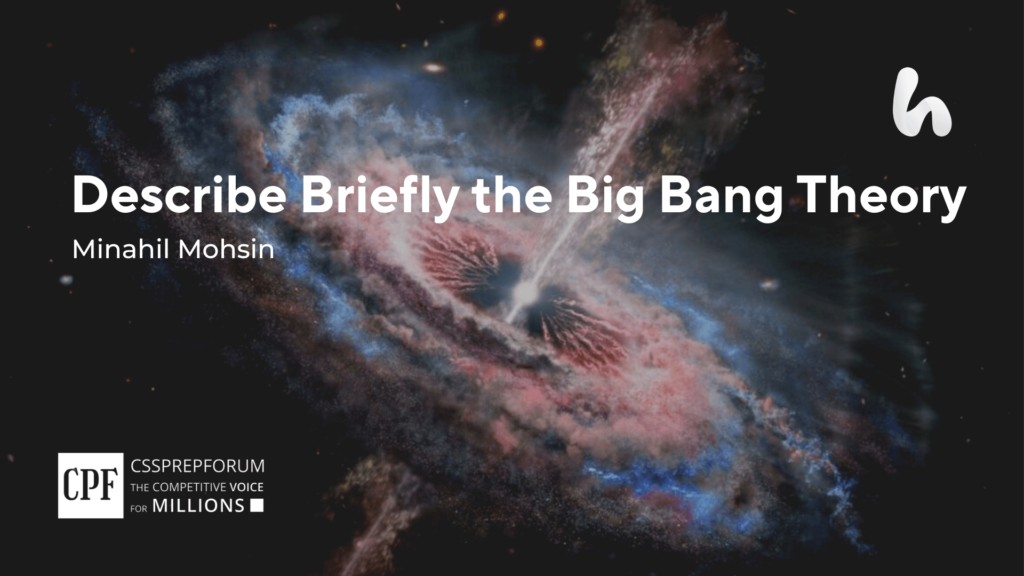The General Science and Ability Past Paper Question has been attempted by Minahil Mohsin, a CSS English and Compulsory Course student. Along with other aspirants, he learns how to prepare and attempt GSA questions to score up to 90 marks under the guidance of Miss Iqra Ali and Dr. Nishat Baloch, Pakistan’s top CSS GSA coaches providing coaching at Howfiv.

In this question, the examiner has asked to describe the Big Bang Theory. Therefore, your answer should contain introduction of this theory and different steps of formation of Universe explained by the Big Bang Theory.
Introduction
The Big Bang Theory is the theory that gives a cosmological explanation of the origin and expansion of the universe. Although many theories have tried to explain the mysterious genesis, the big bang theory is the most accepted in this regard.
According to the Big Bang Theory, the universe originated in the following steps:
1- Singularity
- The universe emerged from a singularity.
- Singularity was a hot, highly dense minute dot with infinite gravity, matter, and energy that made the whole universe.
- At the time of singularity, there was no existence of time, matter, space, and energy.
- As there was very high density, the temperature was about 10 billion degree Celsius.
2- Expansion
- Almost 13.7 billion years ago, the singularity started to expand rapidly by an unknown force, and time and space came into being.
- As the space started to expand, the temperature cooled down, and the universe began to grow.
- All the energy started converting into the matter.
3- Formation of Matter
- Quark, one of the primary sub-atomic particles, was formed after the origin of the universe.
- Quarks rapidly combined to form groups of subatomic particles, which formed the very first elements: Helium and Hydrogen.
Helium, Hydrogen and dust particles combined in the space to form stars. - All other, heavier elements of the periodic table were formed by the massive stars at their explosion.
- Thus, the heavy elements combined to form new stars, new planets, and new life.
- As gravity was present, the irregular-shaped planets and stars changed into round, elliptical shapes.
- As time passed, after billions of years, the present-day universe was formed, containing unlimited galaxies, stars, and planets.
- According to the Big Bang theory, the universe is still expanding, and all galaxies are moving away with certain receding velocity as evidenced by the phenomenon of Red Shift and Hubble’s law.
A quick recipe to score up to 90 marks in CSS GSA paper by Miss Iqra Ali and Dr. Nishat Baloch
Having taught for many years in different universities and being an experienced lecturer, I have devised a strategy for my CSS and PMS students, who aim to score up to 90 marks in the CSS GSA paper. Unfortunately, due to a large number of CSS and PMS aspirants, a very busy schedule, and Sir Syed Kazim Ali‘s rule of taking a limited number of students in CSS English and Compulsory Course to ensure quality rather than quantity and remain the best e-institute, I cannot teach all student. However, under the guidance of Sir Kazim, I have decided to highlight the best strategies that I teach my students to score maximum marks in the paper. All the students may follow them to pass the CSS GSA paper with flying colours. Moreover, to help thousands of CSS aspirants, I have created a separate category where I have uploaded the last 30 years of CSS GSA Solved Past Papers. Or, you can also visit the category GSA Notes, where my students publish their write-ups related to CSS GSA papers.
- Science is not a subject to cram. Therefore, aspirants must not cram the study material but try to grab the concepts and reproduce them on the paper in accordance to the requirements of the question.
- Rather than memorizing and reproducing the content from different sources, students must learn to give their thought words properly, coherently, affectively, and grammatically correct. This gives a pleasant and unique feeling to the examiner as he is always desperate to find the original and unique thoughts out of thousands of papers, and he always appreciates such aspirants by giving maximum marks.
- For preparing General Science, students must practice diagrams with as much topics as possible and reproduce them on the paper, for diagrams, illustrations, and graphs boost the score of the candidate.
- It is commonly observed that students take the MCQs portion very light. However, 20 marks of MCQs are very important as they not only boost the score but also morale of the student. Therefore, aspirants must give due attention and time to the preparation of MCQs portion. Fortunately, Howfiv is the only platform, where an aspirant can find millions of MCQs, along with their explanation, of all the subjects, including GSA, and MCQs should be prepared from Howfiv.
- Furthermore, Ability and Mathematics portion is critical and decisive for the future of a CSS and PMS aspirant. With a little effort and focus, an aspirant can grab full marks in this portion. Therefore, an aspirant must practice different mathematical skills throughout his preparation for the exam.
- Last but not the least, practicing the past papers and getting them evaluated by an expert teacher or lecturer, rather than mere a CSS or PMS qualifier, is the key to achieve up to 90 marks in CSS GSA paper.
Want to read CSS Pakistan Affairs Solved Past Papers and learn how to attempt them to score high? Let’s click on the link below to read them all freely. All past papers’ questions have been attempted by Sir Kazim’s students, who scored the highest in the subject.
CSS Solved Pakistan Affairs

More Essays
Click on any to start reading the essay.
Want to read General Science & Ability Solved Past Papers to learn how to attempt them to score high? Let’s click on the link below to read them all freely. All past papers have been solved by Miss Iqra Ali & Dr Nishat Baloch, Pakistan’s top CSS GSA coach having the highest score of their students.
Articles Might Interest You!
The following are some of the most important articles for CSS and PMS aspirants. Click on any to start reading.












